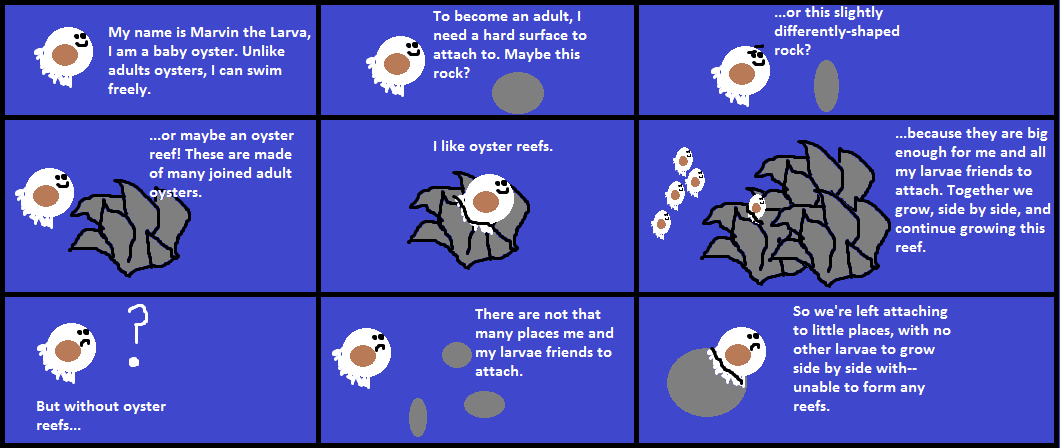85% of the world’s oyster reefs are now gone! This alarming and sad statistic, is due to the destruction of habitat, overfishing, and water pollution. This is worrying, because not only do oyster reefs have many important functions, but once a reef is gone, it is very hard for a new one to grow in its place. Despite that, researchers and volunteers in South Carolina are now installing a new product that can hopefully help new reefs grow: oyster castles! Although it remains to be seen whether these oyster castles can stand the test of time, short-term results seem to suggest they can help new reefs grow.
Why We Should Be Worried
Oyster reefs have many important roles. For example, oysters filter the water they live in, making it more clear and livable for other marine life. Oyster reefs also act as barriers against forceful waves, protecting the shoreline from erosion. Small marine organisms like crabs and small fish live in oyster reefs as well. They also serve a crucial role economically since many people depend on oysters as a source of income. Globally, oyster fishing made almost 700 million USD in 2012 alone.
The importance of oysters makes the worldwide loss of reefs worrying, but the difficulty that oyster reefs have in growing back adds to this concern greatly. Unlike the adult oysters most people are familiar with, baby oysters swim around freely. Eventually, they attach to a hard surface and become non-moving adults. Oyster reefs, which are made of thousands of connected adult oysters, provide a big enough surface for thousands more baby oysters to attach and keep the reef growing. However, when oyster reefs disappear, there are not that many hard surfaces left that have room for enough oysters to make a reef. Hence, when you lose all the reefs in one part of the world, they may never come back.
Enter oyster castles
Oyster castles are large structures, which could provide a big and hard enough base for new reefs to form. These castles are made of mixed cement blocks put together like Legos. Joy Brown of the Nature Conservancy, and teams of various volunteers, have spearheaded the installation of multiple castles across intertidal areas in South Carolina. The idea is that these castles will provide a large enough surface for thousands of oyster larvae to attach, and begin a new reef.
Although Joy is still waiting on long-term results, early results are encouraging. Thousands of connected oysters have been seen growing on these castles, demonstrating the number of oysters needed to form a new reef. These castles have even shown an ability to prevent shoreline erosion. In addition, numerous other species have begun to use these oyster-laden castles as habitat. These are all characteristics one would expect from natural oyster reefs, suggesting oyster castles are doing a good job of restoring coastal reefs.
Success or Sham?
Despite the fact that oyster castles appear to have had many positive effects on their environment, their continued success may face some obstacles. In comparison to other structures that prevent shoreline erosion, such as seawalls and jetties, installation of oyster castles can cost thousands of dollars more and permits to build them are much more difficult to obtain. This, combined with the fact that their current lifespan is not known could deter cities from placing them on their shores.
Supporters of the oyster castles have addressed concerns over oyster castle longevity.
“The theory is that the oysters, over time, will continue to build their shell bed over the previous layers so the castle becomes a living, growing oyster reef”
– Rob Rinehart, Allied Concrete
The use of oyster castles is still very new and their effects must continue to be monitored in order to evaluate their success. However, these simple structures are providing valuable habitat for many marine species that seawalls and jetties do not provide, while having the same shoreline stabilization benefits.
If oyster castles continue to yield the positive results that have been seen to date, they could be a promising solution to oyster declines around the globe.
Want to Help Marvin the Oyster Larva?
Recycle oyster shells! You can help oysters take a step in the right direction by supporting oyster shell recycling. Next time you see oysters on the menu at a restaurant be sure to ask whether the restaurant recycles its shells before you order. Returning shells to their natural environment helps oyster populations grow and thrive and keeps these pieces of an essential ecosystem out of landfills.
References
Collen, B., Bohm, M., Kemp, R., & Ballie, J. E. M. (2012). Spineless: Status and trends of the world’s invertebrates. (). United Kingdom: Zoological Society of London.
Brown, J. (2013). Final Report: Continuation and expansion of oyster reef enhancement efforts using oyster castles on Jeremy Island, South Carolina USA. The Nature Conservancy / NOAA Restoration Center.
Hill, J., Perez, D., & Hoffman, K. (2012). Phase II on north island: Tom yawkey wildlife center living shorelines project, winyah bay, georgetown, SC. (). South Carolina: Nature Conservancy.
Harris, S. M., & Tyson, S. L. (2014). Palmetto plantation oyster castle reef survey. (). South Carolina: College of Charleston.
The Nature Conservancy in South Carolina – Update: Oyster Reef Restoration at Jeremy Island | The Nature Conservancy. (n.d.). Retrieved November 23, 2014, from http://www.nature.org/ourinitiatives/regions/northamerica/unitedstates/southcarolina/howwework/a-new-reef.xml
Kroeger, T. (2012). Dollars and sense: Economic benefits and impacts from two oyster reef restoration projects in the northern gulf of mexico Nature Conservancy.
Schulte, D. M., Burke, R. P., & Lipcius, R. N. (2009). Unprecedented restoration of a native oyster metapopulation. Science, 325(5944), 1124-1128.
National Marine Fisheries Service. (2012). Fishery statistics NOAA.




